The Museum’s mosaic collection includes 26 original works removed from the floor of an Early-Christian 5th-century basilica on the banks of the Ilissos river in Athens, as well as 32 replicas. Two original floor mosaics have also been laid within the Museum – one in 1930 in the courtyard, the second in 1970 at the entrance. They were both excavated in central Athens, the former from a 5th-century bathhouse, the latter from a palace of the later Roman period.
History of the workshop
The workshop was formed in the mid 1960s by the artist and conservator Giannis Kolefas. Until then, the BCM’s mosaics had been conserved by external associates. Giannis Kolefas, one of Greece’s first qualified conservators, studied the Museum’s mosaic conservation needs and assembled a team which rescued mosaics from monuments in Greece, Jerusalem and elsewhere.
The conservation of the mosaic in the Museum courtyard in 1966 was an especially demanding and ground-breaking enterprise by the standards of the time. The mosaic was detached from the floor and re-laid in the same position after conservation.
Between 1969 and 1971, Giannis Kolefas taught at the Museum’s Training School for Conservators of Antiquities, where students benefitted from his knowledge and wealth of experience.
There followed a hiatus of almost three decades, and the workshop did not resume its activities until February 2003, when it was reorganized and re-equipped. Today, the workshop undertakes:
• the preventive conservation and documentation of the Museum’s collection and al fresco mosaics (both originals and replicas);
• the creation of replicas: faithful copies of original mosaics are produced for exhibition, sale and educational use;
• interventional conservation. This includes consolidating mosaics and their support layers; the application of mechanical and chemical cleaning methods; replacing support layers where required; detaching works from walls and floors and relaying them in their original positions or in special moveable frames; and replacing coloured plaster where required.
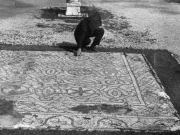 | The mosaic prior to conservation. |
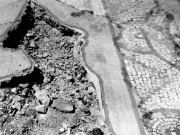 | Removing decayed mortarp and consolidating tesserae. |
 | Removing decayed mortarp and consolidating tesserae. |
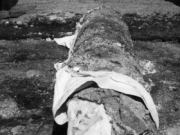 | Detaching the mosaic from the floor using the roll-up method. |
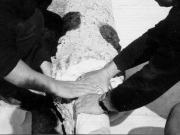 | Detaching the mosaic from the floor using the roll-up method. |
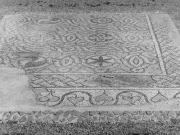 | The mosaic (Â×Ì 1637) after it was relaid in the Museum courtyard.
|
 | Giannis Kolefas with students of the Central Workshop for the Conservation and Restoration of Paintings and Mosaics (KES). |
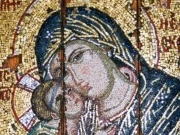 | Ôhe original Virgin Episkepsis, late 13th c., Â×Ì 990. |
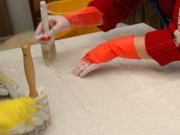 | Copying the mosaic icon of the Virgin Episkepsis, late 13th c., Â×Ì 990. |
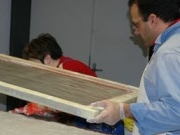 | Copying the mosaic icon of the Virgin Episkepsis, late 13th c., Â×Ì 990. |
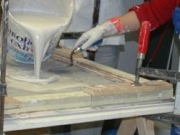 | Copying the mosaic icon of the Virgin Episkepsis, late 13th c., Â×Ì 990. |
 | Copying the mosaic icon of the Virgin Episkepsis, late 13th c., Â×Ì 990. |
 | The copy mosaic icon of the Virgin Episkepsis, late 13th c., Â×Ì 990. |
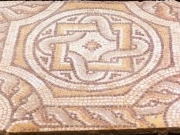 | The section of the mosaic floor from the Early Christian Ilissos basilica, 5th c. (Â×Ì 1762) prior to conservation. |
 | Several of the mosaics in the 5th-century Ilissos basilica were of especial interest from a conservational point of view, as they had been mounted on a support of iron-reinforced grey concrete following their excavation. Here, the conservators are protecting the mosaic surface and removing cement from the section of mosaic floor (Â×Ì 1762). |
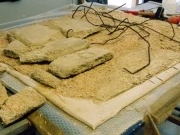 | Several of the mosaics in the 5th-century Ilissos basilica were of especial interest from a conservational point of view, as they had been mounted on a support of iron-reinforced grey concrete following their excavation. Here, the conservators are protecting the mosaic surface and removing cement from the section of mosaic floor (Â×Ì 1762). |
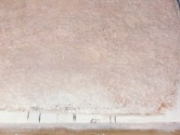 | It was judged necessary to remove the reinforced concrete base because the soluble salts created on the mosaic surface and the products resulting from the corrosion of the iron were considered to pose multiple threats to the work. The mosaic surface was covered with protective cloths prior to the cement being removed and the rear of the mosaic being cleared of the decayed support by mechanical means. |
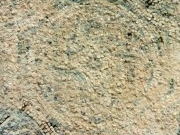 | It was judged necessary to remove the reinforced concrete base because the soluble salts created on the mosaic surface and the products resulting from the corrosion of the iron were considered to pose multiple threats to the work. The mosaic surface was covered with protective cloths prior to the cement being removed and the rear of the mosaic being cleared of the decayed support by mechanical means. |
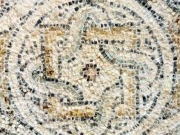 | A new mortar support was subsequently put in place and reinforced with a stainless steel lattice and frame. Finally, the mosaic surface was cleaned and the support tinted. |
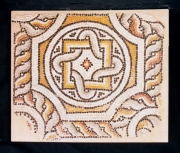 | The section of mosaic floor from the 5th-century Ilissos basilica (Â×Ì 1762) after conservation. |



























